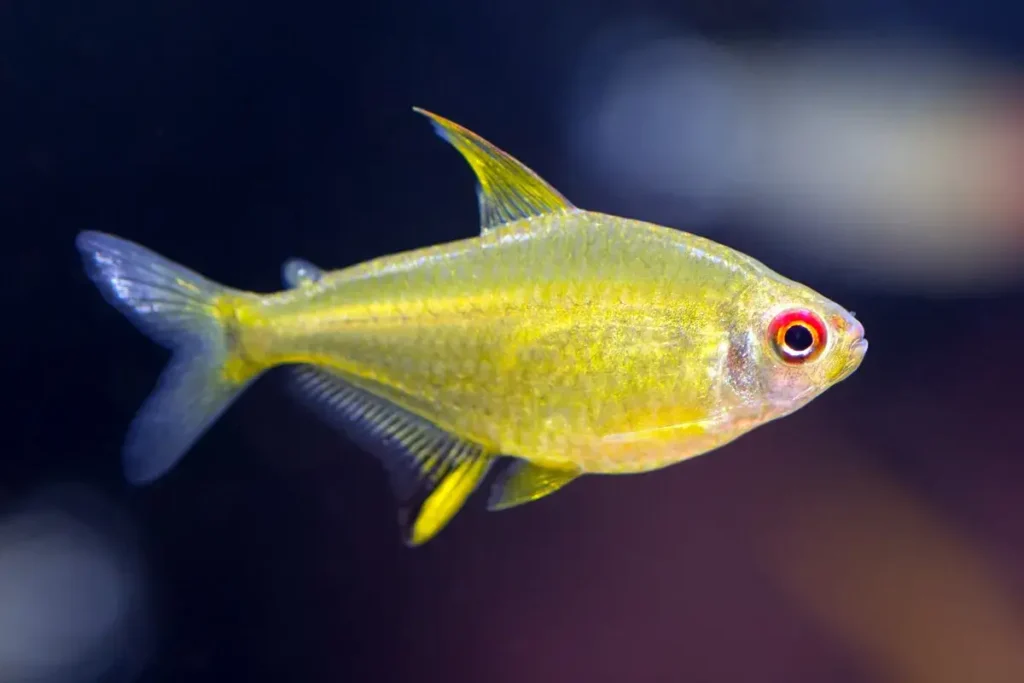
Size
Only 5 centimeters is the maximum length of this tetra.
Physical Characteristics and Behavior
Despite having a stunning color pattern, the Lemon Tetra is not a common aquarium fish. Due to the strain of shipping, they become easily neglected at the store and turn gray. After a week or two, the fish in a planted aquarium will show their natural colors. The body has a certain amount of opacity. Lower on its back, it changes from a golden-brown shade to a warm lemon yellow. The dorsal and anal fins’ black color contrasts sharply with their white or lemon-yellow tips.
Having as a pet
Keeping as Pet

- Water Conditions
It flourishes under conditions with a pH of about 6.0. The water’s dH shouldn’t be more than 25, and it should only be mildly to moderately hard. Since the Lemon tetra is a native of a tropical river, the aquarium water temperature should be kept at 23 to 28 degrees Celsius (73.5 to 82.5 degrees Fahrenheit).
- Care of Aquariums
As long as the water is maintained clean, this tetra is simple to maintain. Since they are closed systems, all aquariums require maintenance. Decomposing organic matter, nitrates, and phosphate accumulate over time, and evaporation-related water hardness rises. Water should be supplied on a frequent basis, especially if the tank is well loaded, to fight these ever-changing conditions. Every other week, the tank water should be replaced by at least 25 to 50 percent.
Water Changes: Every two weeks
- Setup of an Aquarium
Since they are flexible fish, lemon tetras will prosper in the majority of well-kept aquariums. A school of six will fare best in a 15 to 20 gallon tank because they are fairly resilient. Lemon Tetras will look especially great in a highly grown environment, and if the decor is too sparse, they may look a touch washed out. These fish will benefit from some hiding spots and low lighting.
The back and sides of the aquarium should be densely planted, while the front should have a lot of open water for swimming. They appear to perform best when housed in an Amazon biotope tank. The substrate in this arrangement should be river sand, and the decor should include driftwood, twisted roots, and some dried leaves. The water will become stained with the colors of the leaves, giving the tank a more natural feel. Every several weeks, remove the leaves and replace them. For a black water look, aquarium-safe peat can be put to the filter.
- The smallest tank that might accommodate the school this fish needs in order to feel comfortable and display its best colors is a 15-gallon tank (57 L).
- Acceptable for a nano tank:
- Any Substrate Type
- Lighting Requirements: Moderate to Normal Lighting – This fish will look washed out in very strong lighting, particularly if the tank gravel and decorations are bright.
- Breeding temperature is 75.0°F, and these fish will spawn between 24 and 26°C (75 to 78.8°F).
- The Lemon Tetra is best kept in the lower range because it will lose colour at a higher dGH.
- Range ph: 5.5-8.0
- Hardness Range: 3 – 20 dGH
- Brackish: No
- Moderate water movement
- Water Region: All – These fish will move throughout the aquarium’s whole surface.
Table





